

 中文摘要:
中文摘要:
以慈竹为原料,利用相分离法将其中的天然木质素转化为木质素酚。对木质素酚进行了结构表征,并将其用于纸张浸渍,研究了浸渍前后纸张的物理性质。结果表明,慈竹木质素酚质均相对分子质量2884、多分散系数1.60,易溶于丙酮、乙醇、四氢呋喃等常用有机溶剂;相同时间内,未分丝帚化桉木浆成纸对木质素酚(木质素酚丙酮溶液质量浓度为9.13 g/L)的吸收量(12%)略高于分丝帚化桉木浆成纸的吸收量(10%);木质素酚浸渍后纸张的抗张强度、伸长率、耐破度、撕裂度等明显提高,且分丝帚化桉木浆成纸强度提高幅度更大。
 英文摘要:
英文摘要:
In this study, lignophenols were separated from bamboo (Sinocalamus Affinis) using phase separation system. Besides its structure features were analyzed, the resulted lignophenols were used to impregnate pulp fibers to form paper sheets composites. The results showed that the weight-average molecular weight of bamboo lignophenols (Lps) was 2884, which easily dissolved in common organic solvent such as acetone, ethanol and tetrahydrofuran, etc. , dispersion coefficient of the molecular weight was 1.60. The absorption amount ( 12% ) of Lps ( the concentration of Lps acetone solution was 9. 13 g/L) in the paper made of non-fibrillated eucalyptus pulp fibers was slightly higher than that ( 10% ) in the paper made of fibrillated eucalyptus pulp fibers at the same impregnating time. The physical properties of tensile strength, elongation, bursting, tearing etc of the paper impregnated with Lps were significantly improved, more significant improvement of physical strength was founded in the paper made of fluffy short pulp fibers. It indicated that the amount of absorbed Lps was as same important as the properties of pulp fibers. This hinted that it was necessary to adjust the properties of both Lps and pulp fibers to get the best mechanical characteristics of composites.
 同期刊论文项目
同期刊论文项目
 同项目期刊论文
同项目期刊论文
 Isolation of Acetosyringone and Cinnamic Acids from Straw Soda Cooking Black Liquor and Simplified S
Isolation of Acetosyringone and Cinnamic Acids from Straw Soda Cooking Black Liquor and Simplified S Prodution and evaluation of biodegradable composites based on polyhydroxybutyrate and polylactic and
Prodution and evaluation of biodegradable composites based on polyhydroxybutyrate and polylactic and 期刊信息
期刊信息
